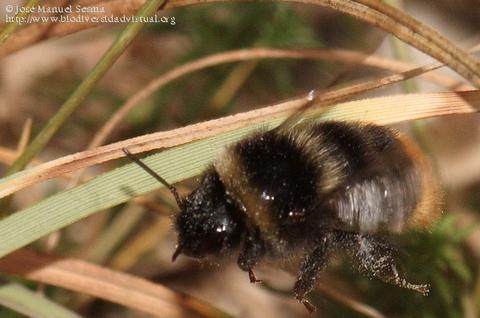Bombus lapidarius
Bombus lapidarius presents a characteristic coloration.
Their body is predominantly black (head, thorax, gaster and legs). But the last segment are rusty red.
Males with short antennae and head as long as wide. Females with slightly longer head than males.
Length of female: 20-22 mm.
Length of male: 14-16 mm.

It has not been evaluated.
No threats described.
Female: head longer than wide. Square malar space. The labral tubers are flattened in its front region, low dotted but definite. Deep labral groove, well delimited. Flattened clypeus, with fine dotted in the disk. Very dotted front in the internal edge of the eyes. On the hind legs, tibia weakly crosslinked; the basitarsus, on the dorsal surface, very pubescent, with yellow feathery hairs. Black setae in the posterior edge. Domed T6, hairless at the center, with the distal end truncated.
Genitalia: narrow external projections of the sting case, which widen in the dorsal region. Internal projections simple, which widen in the middle region.
Males: head as long as wide. Mandibular jaw dense and long. Square malar space with fine and isolated dotted. Short antennas. Middle basitarsus is long, with convergent sides and with long hairs in the proximal half. On the hind legs, convex, crosslinked and matte tibia; the basitarsus is of uniform width.
Genitalia: elongated and narrow. thin sagittae, having a hook at the end. This hooks are convergent, sawn at its end. Long and narrow shuck, with convergent sides. Rounded, small and prolonged in a tooth escuamas. Elongated volselas, with parallel sides.
Bombus lapidarius is distributed throughout Europe, including Russia. Between 350 to 2690 meters.
Potential distribution map at the present time
Potential distribution map in 2050 with the same level of pollution emission and the climate changes consequence of these contamination levels
Map legend
Maps are made with GBIF data of this specie in Iberian Peninsula
The queens emerge in mid-April and build the nest. they establish the nest at different depths, underground, under stones, and even under roofs and attic.
Flight period: April - early October.
Bombus lapidarius form colonies generally very numerous
Bombus lapidarius has preference for meadows, pastures and, even roadsides and gardens.